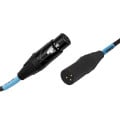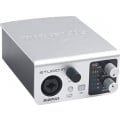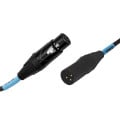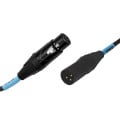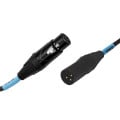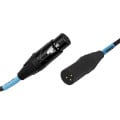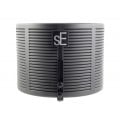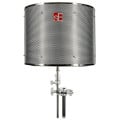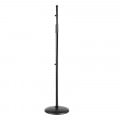Produkt w zestawie z kursem Profesjonalna Obróbka Wokalu
Kurs to zbiór 32 odcinków o łącznej długości ponad 1,5 godziny, prezentujący różne sposoby i podejścia do obróbki wokalu na przykładzie nagrań w różnej stylistyce.
Kurs odpowiada na wiele często zadawanych pytań, m.in.: na czym polega obróbka wokalu?, jakie częstotliwości uwypuklić, aby zwiększyć czytelność głosu i poprawić prezencję?, jakiego rodzaju kompresję stosować, aby wokal „siedział” w miksie?, jakie efekty stosować na wokalu?, jak uzyskać szerokie, stereofoniczne brzmienie wokalu, którego obraz jednocześnie pozostanie w środku sceny dźwiękowej?, czy istnieje takie pojęcie jak „mastering wokalu”?, w jaki sposób szukać wokali w sieci (na przykładzie platformy Splice)?
Mikrofon MXL 2006 posiada membranę o średnicy 1" i jest znakomitym wyborem do nagrywania wokali oraz dowolnych instrumentów. Model 2006 wyposażony jest w wewnętrzne okablowanie Mogami oraz niskoszumny przedwzmacniacz pracujący w klasie A oparty na tranzystorach FET.
MXL 2006 to jeden z najtańszych markowych mikrofonów pojemnościowych wyposażonych w membranę o średnicy 1". Dodatkowo mikrofon sprzedawany jest w komplecie z uchwytem elastycznym i walizką, co gwarantuje komfortowe i bezpieczne użytkowanie mikrofonu przez bardzo długi czas.
Dane techniczne mikrofonu MXL 2006 Mogami:
• Mikrofon pojemnościowy z kapsułą o średnicy 1" [ok. 25 mm] i grubości 6 mikronów
• Pasmo przenoszenia: 30Hz-20kHz
• Charakterystyka: kardioidalna
• Czułość: 15mV/Pa
• Impedancja: 200Ω
• Stosunek sygnał/szum: 80dB [Ref. 1Pa A-ważone]
• Max. SPL przy 0.5% THD: 130dB
• Zasilanie: Phantom 48V ±4V
• Pobór prądu:
• Kolor obudowy: srebrny
• Zawartość zestawu: mikrofon, walizka, uchwyt elastyczny [kosz]
MXL 2006 Mogami - Microphone + vocal processing course
Professional vocal processing - time: 02h 34m 31s, 32 parts
In this series, we present a collection of episodes presenting various ways and approaches to vocal processing on the example of recordings in various styles. We start by discussing correction techniques and multi-stage compression, which allows you to equalize the dynamics of vocal performances and embed them in the context of the arrangement. Mistakes made at this stage often result in a mix sounding amateurish, with vocals "jumping out of the mix" or failing to "break through" - especially with dynamic background music.
Then we move on to discussing the processing examples in the context of the mix, because only this approach allows us to say that all treatments have been carried out correctly! We start with a beautiful ballad by Funky Trip Foundation entitled We Don't Care, proving that a few basic treatments are enough to make vocals sound great (the videos come from the series titled Mix course in funk style)
In the episodes, Maurizio Barusse demonstrates how the vocal processing process works on the large-format Carlec S2 console using external, hardware effects processors. At the same time, he reveals a few secrets about backing vocals that require a different approach, especially when it comes to correction and modulation effects (the videos come from the Mix Course from Warsawmix).
Rap recordings usually require a slightly different approach. Their processing is in fact very similar to the post-production of the voice-over in TV commercials. We focus on proper EQ and fairly strong compression, varying the settings for the main part and backing vocals (the videos are from a hip-hop mixing course!).
The next example shows the process of matching and editing vocal takes from a sample library. Our work does not end with correction, compression and adding a pinch of spatial effects. In the next two videos, we show how to use automation on send channels to, for example, blur vocals in transitions or create sound stamps from fragments of the main line (the videos come from the Vocal House Masterclass course).
We don't always deal with whole vocal lines. Short phrases require a different approach and allow for interesting spatial effects. We work with Vari-mu compressor emulations and effects inspired by iconic Lexicon devices, using convolutional reverb in an unusual way (the videos come from the Brushee track mix course)
The course answers many frequently asked questions, including:
- what is vocal processing?
- what frequencies to emphasize to increase voice intelligibility and improve presence?
- what kind of compression should be used so that the vocals "sit" in the mix?
- what effects to use on vocals?
- how to get a wide, stereo vocal sound, the image of which at the same time remains in the center of the soundstage?
- is there such a concept as "vocal mastering";)?
- how to search for vocals in the network (on the example of the Splice platform)?
After purchasing the course, you will receive a license with a code to get a 180-day subscription to watch the course ONLINE.
Episode list:
1. Correction of vocal tracks and...
2. Two-stage vocal compression
3. Vocal processing (pop/funk)
4. Reverb and tape echo on vocals...
5. Lead vocals and backing vocals (pop/rock)
6. Compression and reverb on vocals...
7. Backing vocals (pop/rock)
8. Finished Deck vs. Multitrack Recording...
9. Development of the timbre of the voice (hip-hop)
10. Fighting Sibilants (Hip-Hop)
11. Multistage Vocal Compression...
12. Tape echo on vocals (hip-hop)
13. Chorus Vocals (Hip-Hop)
14. Splice Sounds, or how to find...
15. Complete vocal processing (house)
16. Vocal placement in the mix...
17. Editing vocal tracks (house)
18. Shipping effects (house)
19. Distorted vocals
20. Vocal correction (downtempo)
21. Vocal compression (downtempo)
22. Removing sibilants with...
23. Refining the timbre of the vocals (downtempo)
24. Creating space (downtempo)
25. Sampling - vocal recording (electro)
26. Vocal Effects (Electro)
27. Speakerphone and post-production...
28. This is house music (house)
29. Soul Vocals (House)
30. DELAY IN THE MIX - Radio delay...
31. DELAY IN THE MIX - Dark delay...
32. DELAY IN THE MIX - A short echo...
Designed with a large, highly sensitive 32mm condenser capsule, MXL 2006 captures the details and nuances of vocals, acoustic guitar, electric guitar cabinets, and even steps up for recording percussion. Its impressive sound quality is backed by impressive engineering like Class A circuitry and a balanced transformerless output for outstanding results in recording studios or live applications.
- Vocal mic with a large 32mm capsule for superior sound
- Clean recordings that highlight vocal nuances
- Class A circuitry that gives pure, natural recordings
- Also excellent for acoustic guitars and percussion
- Great for R&B, pop, rock and hip-hop
- Type: Condenser pressure gradient mic with large 25mm diaphragm capsule
- Frequency Response: 30Hz - 20kHz
- Polar pattern: Cardioid
- Sensitivity: 18mV/Pa
- Output Impedance: 150 ohms
- Equivalent noise: 16 dB (A-weighted IEC 268-4)
- S/N Ratio: 78 dB (Ref. 1Pa A-weighted)
- Max SPL for .5% THD: 130 dB
- Power Requirements: Phantom Power 48V +/-4V
- Size: 50mm x 190mm
- Weight: 1.3 lbs/589.67g
- Metal Finish: Silver

Firma
Produkty
Statystyki napraw













